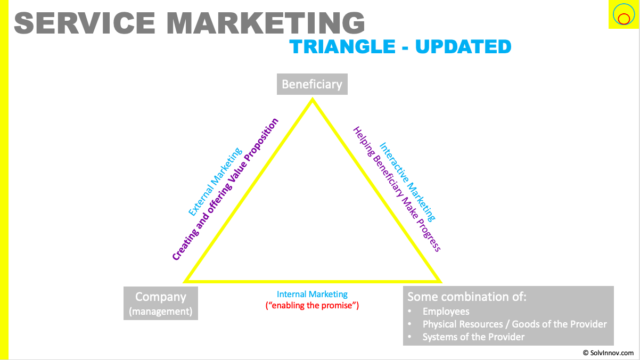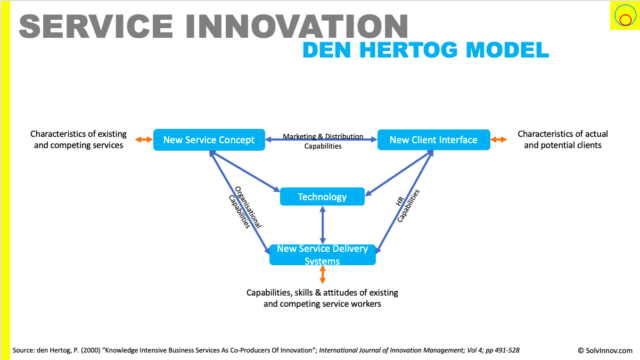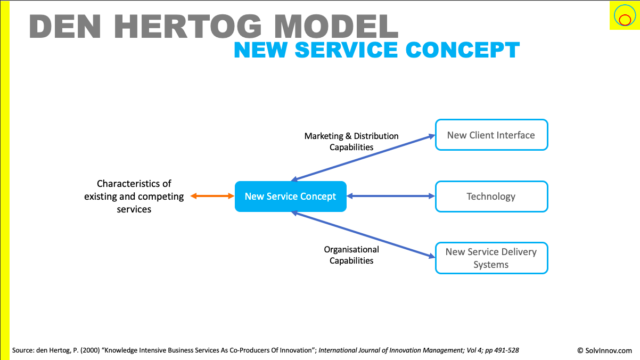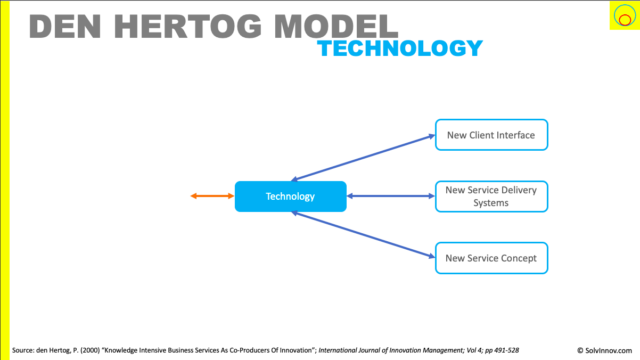The Big Picture…
Back in 2000, Pim den Hertog introduced a 4-dimensional services innovation model. It helps us describe and understand service innovations. And I’ll claim it helps us do much more.
The model has three components:
- Four dimensions – new service concept, new client interface, new delivery system and technology options
- Three capabilities – HR, Organisational and Marketing & Distribution
- Three comparisons – on the outside dimensions: to existing & competing services; actual & potential customer; and to service workers;
Any service innovation will be a mix of changes to dimensions. Perhaps identified by the comparisons. And implemented by the capabilities. We look at this model in this article.
Den Hertog later introduced a 6-dimension model with the revenue model and business partners. Whereas I enhance this 4-dimension model to reflect service-dominant logic and the modern data/technology-driven world in my “A Modern Services Innovation Framework” article.
Implications
What can we do with such a model? Well, the original purpose is for explaining an innovation. And that we certainly can do. But there is more power here than originally thought. We can also leverage the model to:
- Systematically search for innovations (hints of Blue Ocean strategy here)
- By examining the relationship between the size of change and strengths of enterprises capabilities:
- Identify Execution Complexity of Innovations
- Engineer down complexity
- Justify:
- Increasing capabilities
- Enabling activities that do not lead directly to the survivability of enterprise
- Manage a Portfolio of innovations
Before we jump into the model, let’s remind ourselves of the classic service marketing triangle. That, for me, sets up why den Hertog’s model helps us explain a service innovation.
Setting the scene: the services marketing triangle
The service marketing triangle says that three actors work together to deliver any service. These are the company (management), employees, and, importantly, the customer. And that between those actors are three marketing activities. I’ve updated the original triangle to reflect a service-dominant logic viewpoint (see Figure 1).

Firstly, the enterprise creates and offers a value proposition towards potential beneficiaries. This is an offering of how the enterprise thinks it can help a beneficiary make progress in some aspect of their life. And progress can be functional and/or non-functional. For more on this, see my article on value. Secondly, the employees help the beneficiary make progress. And to do so, they need the enterprise to enable them. You might notice the employee aspect is wider than the original marketing triangle. Covering physical resources, goods and systems of the provider in addition to just employees. This reflects our service-dominant view that everything is a service.
Why are we starting here? Well, a service innovation will change one or more of:
- the value proposition
- how our wider definition of employees are enabled to help the beneficiary
- how the beneficiary is helped
We could perhaps see that through the service marketing triangle. But den Hertog’s model makes it easier by, in a sense, twisting the service marketing triangle inside-out.
Introducing den Hertog’s 4-dimensions services innovation model
In 2000, den Hertog published a 4-dimension model of services innovation (Figure 2).
There are three distinct aspects we should note. First, there are four dimensions. And these are the new service concept, new client interface, new service delivery systems and technology options.
Then we have various capabilities of the organisation that link the dimensions. These are the HR, marketing & distribution, organisational and technology capabilities. Although technology capabilities is not explicitly pulled out by den Hertog.
And finally, there are three comparisons. These compare each of the outer dimension with the existing situation. For example, the new service concept should be compared to the characteristics of existing and competing services.
Now we can say that a service innovation is a change in one or more of the dimensions. And I would argue also in capabilities.
So let’s dig into these in more detail, starting with the more concrete New Client Interface.
New Client Interface
The new client interface is where the rubber meets the road. That is to say, where the beneficiary interacts with the other resources to deliver the promise.
And the examples of new client interfaces are numerous! As den Hertog points out:
These interfaces are the focus of a good deal of service innovations…
den Hertog (2000)
Though he also tellingly finished the above sentence with:
…though innovation studies, with their focus on mass manufacturing, have tended to overlook the changes occurring in these interfaces
den Hertog (2000)
Banks are full of examples of client interface innovations. We remember them moving from face-face high-street branches to faceless call centres, changing location. Followed by introducing telephone menu systems – a change in the process. And then using off-shore employees.
But we see digital native enterprises challenging banks. Through simple, intuitive mobile apps – a new client interface. Often focussing on specific tasks. And doing them very well.
And as we move forwards, bots and Artificial Intelligence are replacing human interactions. Such as Amelia here:
And AI is humanizing previous non-human interactions. Rather than searching, we can just shout out “Hej Siri, what is today’s weather?”.
But some client interface innovations are accelerated by external events. Think of the changes 2020/21’s COVID-19 pandemic introduced.
Den Hertog tells us we should make a comparison.
Comparisons
Den Hertog proposed that new client interfaces should be compared to the characteristics of actual and potential clients. Though he never expanded on this. But what can we pull out of this?
Firstly, it’s about the servicescape. The environment in which the service takes place. How does that meet the progress your actual beneficiaries are seeking to make. And here we are probably, but not exclusively, talking about non-functional progress – safe, secure, easily, in-person etc.
As well recognising the beneficiary often brings skill and competence to the service provision. Do they have those, or do we need to train them? Are there skills and competence they gain in other industries/markets we can make use of? For example use of QR codes to quickly transfer information or indication of ownership (train/plane tickets, concert tickets, low-level proof of identity etc). What is the change journey we need to take the beneficiary on? How do we address innovation adoption and innovation resistance?
Secondly, it’s important to think of your interface through the eyes of potential beneficiaries. And this also means your current non-customers. Here is where I believe Blue Ocean strategy can help [add link to article when written].
Capabilities
Den Hertog’s links new client interfaces to the other dimensions. And highlights two capabilities.
New client interface links to service delivery system via HRM Capabilities (human resource management). Where the idea is that a new client interface likely requires changes to the service delivery system. Moving, for example, from physical to online presence. Or from human interactions to AI bots.
Similarly, changing the client interface will often change the service concept. And a changed service concept is really a changed value proposition. And so Marketing & Distribution capabilities are best placed to drive that change.
Finally, there is a link to the technology dimension. However, I see no explicit mention of technology capabilities.
Let’s move on to quickly review new delivery systems next.
New Delivery System
We can see the delivery system as the operand and operant resources that the beneficiary uses to help them make their progress. Den Hertog is envisaging the people, culture, organisation and processes of an organisation.
And with our service-dominant logic hat on, we include also the systems of the enterprise. As well as the physical resources. And the goods. That’s to say, the bottom right of our updated services marketing triangle from Figure 1. Where the latter may seem strange. But we see goods as a way of freezing service so it can be distributed for use later and elsewhere.
When we change any of the above, then we are implementing a new service delivery system.
Comparisons
Den Hertog’s advice is to compare delivery system with the capabilities, skills and attitudes of existing service workers. As well as with competing service workers. And this makes sense as:
service is the application of skills and attitudes from the benefit of another entity, or the entity itself.
So we should see how our capabilities and skills match to those needed for the new service delivery system. And comparing against competing service workers also makes sense. Since we know that operant resources, which includes service workers, is the fundamental source of competitive benefit.
But let’s not forget goods. These are the encapsulation of service for distribution. Often for the beneficiary to use in a self-service act or as part of the ongoing service provision.
Capabilities
If we change the delivery system, then we often change the client interface or the service concept. And often there is a technology change.
And impacts on the client interface caused by a new delivery system will require the organisational capabilities of the enterprise. Whereas impacts on the service concept are likely to require HR capabilities, reorganising departments etc.
Sometimes an innovation might create new roles. Say you introducing learning bots, then you might want to introduce a new role/processes to monitor the bot and ensure it stays on-brand. As an example of what happens when you get it wrong, I can point to Microsoft’s Tay’s meltdowns – “Microsoft’s racist chatbot returns with drug smoking Twitter meltdown“.
But some innovations are more internal – or enabling as we can call them. For example, moving from a waterfall software development approach to agile ones.
Let’s move on to look at the more abstract dimension of new service concept.
New Service Concept
What are
- solving a problem,
- reducing a hindrance, or
- helping the beneficiary get a job done.
These concepts could be new to the world, to the market/industry, or to the firm. And they cover the full range of innovation (as defined by Gallouj & Weinstein): radical, improvement, incremental, ad hoc, re-combinative and formalisation.
Air B’n’B, Spotify, Skype are all examples of new service concepts, in their time. Voice and video telephony without the need for a phone. Why own a limited set of music when you can stream an infinite amount? Renting out spare capacity in your accommodation. So are Wise, solving the beneficiary’s hassle (usually caused by banks) of transferring money across currency boundaries. Or Sweden’s Swish, helping beneficiaries, instantly and securely, move money between their own and friends bank accounts. And now used as a Customer-2-Business payment method.
An interesting example, that I dig deeper into, is Electrolux moving one of their goods to be a service. Instead of buying a vacuum cleaner you can buy cleaning as a service. That service includes support packs being sent at specific points to ensure optimal performance.
Comparisons
A new service concept should be compared to characteristics of existing and competing services. And Christensen tells us that competitors includes doing nothing.
Capabilities
New service concepts are likely to go hand in hand with a new client interface and/or a new delivery system. And are often, nowadays, enabled/driven by technology options.
Let’s take the Electrolux example. When buying a vacuum cleaner as a goods, we typically go to a retailer, buy the product, take home and use. Behind that there is the production. And the distribution channels to get from manufacturer to retailer.
As Electrolux move to providing vacuum cleaning as a service several client interface and delivery system changes are required. Firstly, the way the beneficiary buys changes. Electrolux become the retailer. And it’s an online retail experience. So changes are required in the interface for purchasing. Changes also come in Electrolux taking on the support role to beneficiaries. Also, the distribution model becomes B2C (business to consumer) rather than B2B (business to business). And to communicate back to Electrolux – enabling billing and support services – the device needs to connect to the internet.
Enabling these changes in client interface and delivery system are the enterprise’s marketing, distribution and organisational capabilities.
Finally, we arrive at the final dimension – technology options.
Technology Options
Hertog’s 4th dimension is technology options. He writes, in 2000, that service innovation clearly happens without the need for technology innovation. But, that in practice, there is a wide link.
However, as far as I can read, he talks of no technology capabilities of the enterprise. WHich I really think shold be there.
We can classify technology options as technology push or technology pull. In technology push we have a technology innovation and are trying to find problems where it can be used. The use of Blockchain outside of crypto currencies feels an appropriate example here. Who knows, perhaps that technology will gain its moment with immunity passports.
Technology pull, on the other hand, is where we have a known problem and are seeking a technical solution. A highly relevant, at the time of writing, tech pull innovation is the search for a COVID-19 vaccination. We are in the middle of a global epidemic and have a deep need for a technological solution.
Technology options can be the driver behind all the one, or more, or all other dimensions. For example, the recent proliferation of pay-for-use electronic scooters touches all dimensions. It is reliant on increased battery life, GPS (for tracking/billing). And also on new client interface – the apps used to unlock scooters and associate them with a particular user. As well as delivery systems – introducing new roles that go out and replace battery units.
So, now we’ve looked at the dimensions, capabilities and comparisons, how can we use den Hertog’s model?
How can we use this model?
The original purpose of the model was to describe/understand service innovations. And that it can do. But there are additional uses:
- Systematically search for innovations (hints of Blue Ocean strategy here)
- By examining the relationship between the size of change and strengths of enterprises capabilities:
- Identify Execution Complexity of Innovations
- Engineer down complexity
- Justify:
- Increasing capabilities
- Enabling activities that do not lead directly to the survivability of enterprise
- Manage a Portfolio of innovations
Describing an innovation
Using the model we can simply describe what changes are to be made in each of the dimensions to describe what a particular innovation means.
Systematically search for innovations
Recall that the model has several comparisons built in.
I believe the comparisons aspect is a nice feed into looking at service from a Blue Ocean Strategy lens. In particular taking the strategy map and using new service concept, new client interface, and new service delivery systems as the x-axis.
We can also look across markets and industries to see what is being used and can be carried into our market/industry. Something we can see has happened with QR codes being used as “tickets” now in multiple industries.
Execution complexity of Innovation
If we know the size of the change our innovation requires in the dimensions, and can judge the power of our current capabilities; then we can “simply” calculate the execution complexity of a proposed innovation. There is of course some subtleties in this, but it works as a guiding model.
As part of Portfolio Management
Let’s say we have a set of innovations we would like to implement – a portfolio. If we can assign an execution complexity to each one, then we have the basis for portfolio management. Coupling execution complexity with a measure of potential value to the beneficiary for each innovation allows us to decide which innovations to execute first.
Engineering down complexity
But that’s not all. If we know the execution complexity of an innovation, then we can try and engineer that down. We could look to reduce the size of the change in client interface, delivery system or service concept. Or we could look to the next point.
Increasing Capabilities
Rather than, or in addition to, engineering down complexity of an innovation we could increase our capabilities. And the model allows us to argue for this case.
Justifying enabling innovations/activities
Not least, sometimes innovations will not have a direct impact on beneficiary value generation. But they can reduce complexity of future innovations. Cleaning masterdata, for example, has limited benefit on its own. But it clears the path for interesting machine learning algorithms. Shifting to agile development methodologies should make future developments quicker and able to focus on valuable offerings earlier, pivoting as needed.
Wrapping up
Den Hertog’s 4-dimension model from 2000 is a perfectly usable model for exploring service innovations. However, in the 19+ years since publishing, the world has changed a little. Service is more dominant, technology is playing a greater and greater role, etc. And we have some new theories that are helpful.
Den Hertog updated his model in 2010 to a 6-dimension model. That added two dimensions – New Business Partner and New Revenue Model and breaks the new delivery system dimension into two: technology as well as people, organisation & culture.
And, in my next article,








